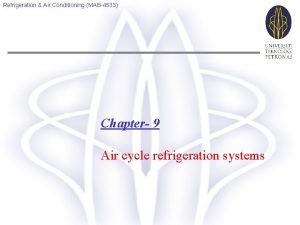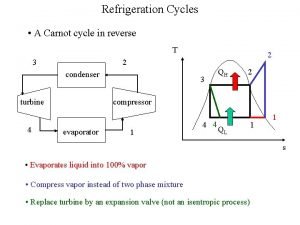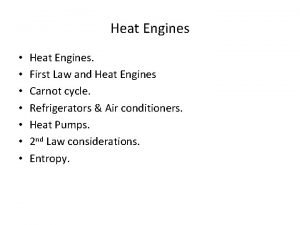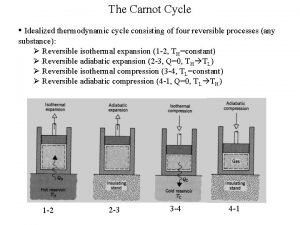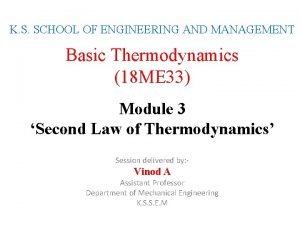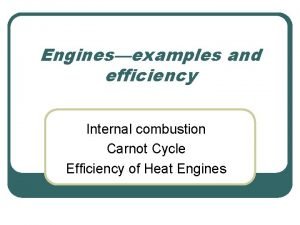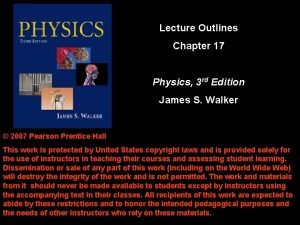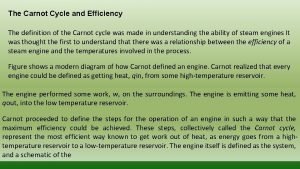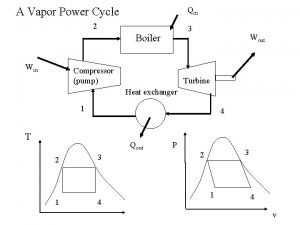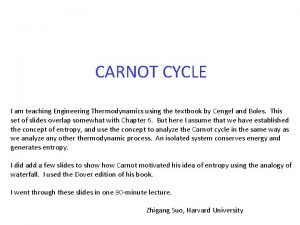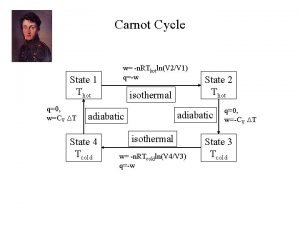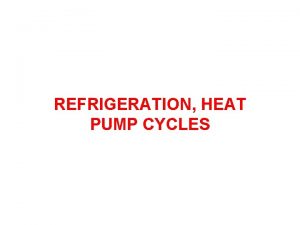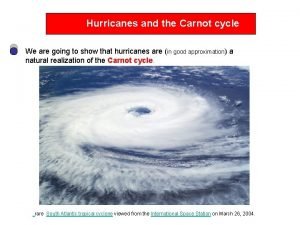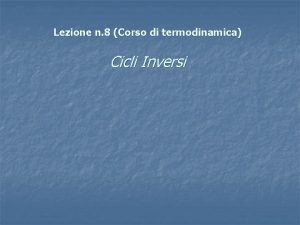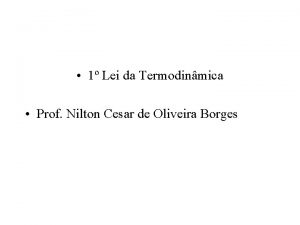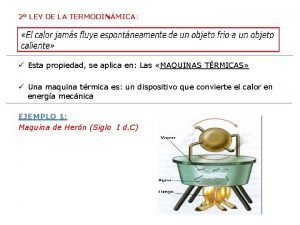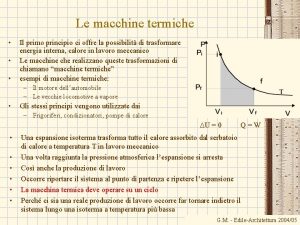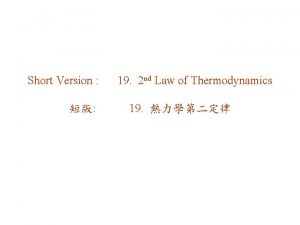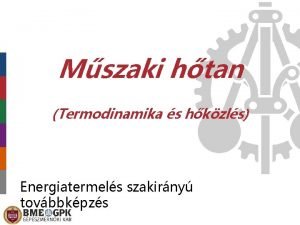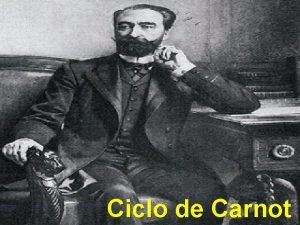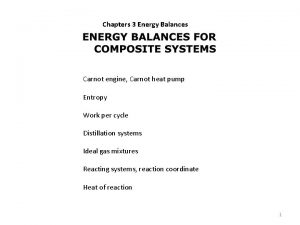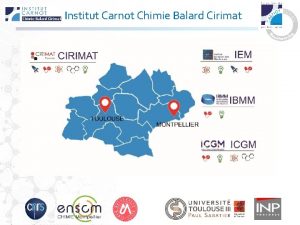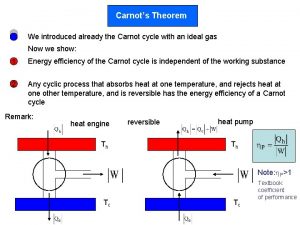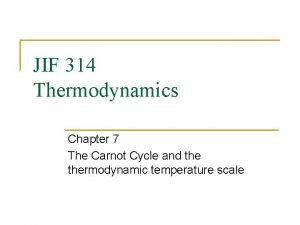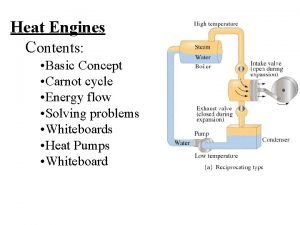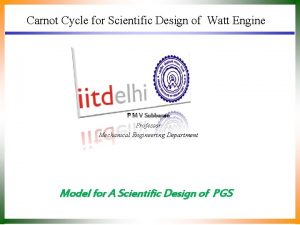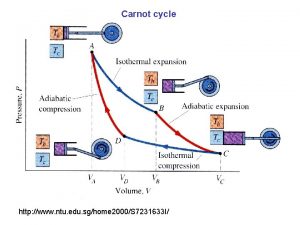Carnot cycle 1 Carnot cycle 2 Carnot cycle



















- Slides: 19

Carnot cycle 1

Carnot cycle 2

Carnot cycle The machine performs positive mechanical work during the expansion steps 1 and 2, the total amount of the positive work is given by the area marked as red in the figure. The machine performs negative mechanical work during the compression steps 3 and 4, the total amount of the negative work is given by the area marked as blue in the figure. 3

Carnot cycle: efficiency Carnot main motivation to study heat engines was the problem how to increase the efficiency of real thermodynamic machines. He designed the Carnot cycle to study the efficiency in general. The efficiency of the Carnot machine is defined as Once we calculate all the state parameters relevant to the Carnot cycle it is easy to calculate the efficiency. One gets a simple formula 4

Note on efficiencies There are frequent misconceptions concerning the notion efficiency: • that it is a physics notion defined like (power output)/(power input) • that efficiency is always less than 100 % There is no unique technical definition of efficiency and it is more an economics notion than physics notion. The idea can perhaps be symbolically defined as To be mathematically consistent one has to quantitatively express both “performance” and “price” in same units. It may be dollars, watts, amount of water (like amount of water pumped out of a mine compared to the amount of water needed to turn the water wheel driving the pump), etc. The efficiency can easily be much larger than 100%. A drastic example might be a picklock priced 100 $ to steel a luxury car priced 1 million $. The efficiency is 10000 % (until you get caught by the police). 5

Carnot cycle: efficiency We have defined the efficiency of the Carnot machine as 6

Carnot engine as a refrigerator Carnot cycle is reversible so the engine can run in the opposite direction. Instead of producing useful work it consumes mechanical work, “receives” heat from the cold body 7

Carnot engine as a heat pump Carnot engine run in the reverse direction can be used not only as a refrigerator to cool the cold but also as a heater to heat the hot. To get a heat pump for heating you can in principle take a standard refrigerator, throw away its door, open the balcony and insert the refrigerator into the balcony door so that the interior of the refrigerator is seen from outside the building like here in the picture. If you look from inside the room you will see the backward side of the refrigerator with the (black) heat exchanger replacing the balcony door. If you switch on the refrigerator it will start to cool the outside atmosphere an heat the room by the hot heat exchanger 8

Carnot engine as a heat pump 9

Carnot theorem The Carnot theorem states: No engine operating between two heat reservoirs can be more efficient than a Carnot engine operating between the same reservoirs. 10

Carnot theorem: “proof” according to the assumption: 11

Carnot theorem: “proof” 12

Second law of thermodynamics We arrived at the statement that it is not possible to construct perpetuum mobile of the second kind. Notice that we did not prove it. We just said we believe it cannot be constructed. We believe it so strongly that we have promoted this statement to be a deep principle of physics: the second law of thermodynamics. All our experience suggest, that perpetuum mobile of the second kind is not possible. As anything in physics, we cannot prove it. Just saying “it would be too good to be true” is just a cliché, not a proof. Impossibility of perpetuum mobile of the second kind is just one possible formulation of the second law of thermodynamics. There are many other, physically equivalent, formulations. Like this one: Heat cannot spontaneously “flow” from cold system to hot system without external work being performed. This can be reformulated as: It is not possible to construct absolute refrigerator, which would be a device able to “pump heat” from cold region to hot region without need “to pay” for some mechanical work. Refrigerators are possible, we have one at home. But we have to pay for the electricity. It is easy to demonstrate the connection to the Carnot theorem. 13

Carnot theorem: absolute refrigerator is impossible according to the assumption: The framed statement says that the net heat is “pumped out” from the cold reservoir by the green framed compound machine without need of external work, so we have got absolute refrigerator. 14

Thermodynamic temperature The second law of thermodynamics allows us to define temperature independently of the medium. Up to now we had defined the temperature for gas like this: Temperature of gas in equilibrium is given by the mean kinetic energy of the translational movement of molecules as 15

Thermodynamic temperature The definition of thermodynamic temperature through the efficiency of Carnot machine is perhaps not directly usable for practical metrology. It serves as a unique theoretical definition and for practical purposes we have to use some device (perhaps different devices for different temperature regions) for which we have a reasonable statistical theory which can be directly related to thermodynamic definition of temperature. Actually the term “thermodynamic temperature” is not uniquely defined in physics literature. During our lectures we shall meet several other definitions also referred to as “thermodynamic temperature”. All of them are theoretically equivalent. Strangely enough even the official legal document defining SI units by International Bureau of Weights and Measures (French: Bureau international des poids et mesures, BIPM) is of no help to uniquely identify the notion of “thermodynamic temperature. In the official definition of Kelvin it just says (https: //www. bipm. org/en/measurement-units/): The Kelvin (K) is the fraction 1/273. 16 of thermodynamic temperature of the triple point of water. There is no further specification of what the notion thermodynamic temperature means. It is implicitly assumed that “it is explained somewhere” in the physics literature. The notion of temperature is abstract enough that one feels rather unsure like “what they 16 speak about”.

On the other hand, BIPM uses the same strategy in defining other, more common, units like meter The meter is the length of the path travelled by light in vacuum during a time interval of 1/299 792 458 of a second. Here one first does not feel unsafe, what is meant under the definition “length of the path”, which seems to be intuitively clear. However, anyone interested in more careful thinking will recognize that the precise definition is not simple at all and soon he will be trapped in the labyrinth of general relativity. 17

Quantum mechanics We shall need basic knowledge of quantum mechanics. Here we shall present a few elementary facts about quantum mechanics. In principle you will be able to follow our statistical physics course if you accept these facts. • Microworld is discrete in the following sense: there exist special stationary states of a quantum system which are discrete. These states are usually identified by a set of (a few) discrete “quantum numbers”. • Quantum mechanics usually predicts experimental results only probabilistically. This is not due to some incompleteness of the quantum theory, it is a fundamental property of the microworld. However, if a system is in one of its stationary states, then its energy is precisely predictable. Since the stationary states are discrete this means that the energy spectrum (set of possible energy values) is discrete. • The stationary states are not the only possible states of a quantum system. There are so called superposition states not having uniquely predictable energy. However, it can be proved that for the purpose of describing statistical physics equilibrium states it is enough to consider only stationary states. • There may be different stationary states having the same energy. This is called energy degeneration. The energy level belonging to several different stationary states is called degenerated.

Quantum mechanics
 Air cycle cooling system
Air cycle cooling system Carnot cycle refrigerator
Carnot cycle refrigerator Carnot cycle animation
Carnot cycle animation Carnot cykel
Carnot cykel Reversed carnot cycle
Reversed carnot cycle Carnot cycle
Carnot cycle Carnot cycle efficiency depends upon
Carnot cycle efficiency depends upon Define carnot engine
Define carnot engine Carnot vapor power cycle
Carnot vapor power cycle Carnot cycle
Carnot cycle Carnot cycle
Carnot cycle Reverse carnot cycle
Reverse carnot cycle Hurricane carnot engine
Hurricane carnot engine Ciclo di carnot inverso
Ciclo di carnot inverso Ciclo de carnot
Ciclo de carnot Máquinas de carnot
Máquinas de carnot Supponiamo che una cella frigorifera si comporti
Supponiamo che una cella frigorifera si comporti Sebuah lemari es memiliki koefisien daya guna 7
Sebuah lemari es memiliki koefisien daya guna 7 Carnot cop
Carnot cop Diagram t-s termodinamika
Diagram t-s termodinamika
